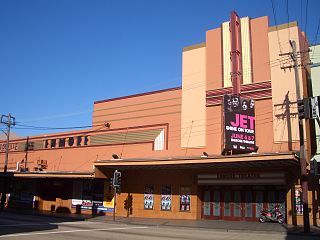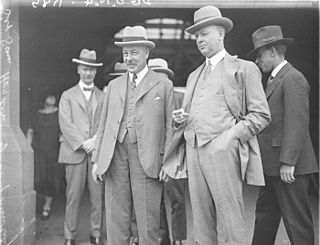Related Research Articles

The Enmore Theatre is a theatre and entertainment venue in Enmore, New South Wales, Australia.

The Athenaeum or Melbourne Athenaeum at 188 Collins Street is an art and cultural hub in the central business district of Melbourne, Victoria, Australia. Founded in 1839, it is the city's oldest cultural institution.

Sir Samuel Hordern was an Australian businessman, animal breeder and philanthropist. Born into the prominent Sydney trading family, Hordern directed the family company of Anthony Hordern & Sons from 1909 to 1926.

Anthony Hordern & Sons was a major department store in Sydney, New South Wales, Australia. With 52 acres of retail space, Anthony Hordern's was once the largest department store in the world. The historic Anthony Hordern building, which was located on a block bounded by George Street, Liverpool, Pitt and Goulburn Streets, on what was a small hill called Brickfield Hill in the Sydney central business district, was controversially demolished in 1986, to make way for the World Square development.

Brickfield Hill is a City of Sydney locality in the Sydney central business district, Australia. The name was used for the surrounding settlement serving the colony's growing need for bricks, and today is part of the suburb of Surry Hills.

Eureka Stockade is a 1907 Australian silent film about the Eureka Rebellion. It was the second feature film made in Australia, following The Story of the Kelly Gang.
The MacMahon brothers were entrepreneurs in Australian show business. Chief among them were James MacMahon and Charles MacMahon, who together and separately toured a large number of stage shows. Their younger brothers, Joseph and William, were involved in many of those activities.
Spencer Cosens best known as Cosens Spencer and posthumously as Charles Cozens Spencer, was a British-born Canadian film exhibitor and producer, a significant figure in the early years of the Australian film industry. His company Spencer's Pictures was an early backer of Raymond Longford before it was absorbed into the conglomerate which became known as "The Combine".

Sentenced for Life is an Australian film directed by E. I. Cole. It was an adaptation of a play performed by Cole and his Bohemian Dramatic Company as early as 1904.

Dan Morgan is a 1911 Australian film from Cosens Spencer about the bushranger Daniel Morgan. It was said to be starring "Alfred Rolfe and company". Rolfe directed three movies for Spencer, all starring himself and his wife Lily Dampier so there is a chance he may have directed this one and that it starred his wife. A prospectus for the Australian Photo Play Company said he directed it. It is considered a lost film.

The Municipality of Paddington was a local government area of Sydney, New South Wales, Australia. The municipality was proclaimed on 17 April 1860 and, with an area of 1.7 square kilometres, included the entire suburb of Paddington and parts of Edgecliff. The council was amalgamated with the City of Sydney to the east with the passing of the Local Government (Areas) Act 1948, although the former council area was transferred in 1968 to the Municipality of Woollahra, transferred to the City of South Sydney in 1989 and was then split in 2003 between the City of Sydney and the Municipality of Woollahra.

John Albert Delany, usually referred to as John A. Delany, was an organist and composer in Sydney, Australia, a champion of choral music. He has been called "Australia's greatest musician" and "The Australian Gounod".
Isaac Earnshaw was an Australian trainer and owner of thoroughbred racehorses.

The Wilcannia Athenaeum is a heritage listed, rusticated sandstone building in the town of Wilcannia, New South Wales. Built in 1883 and located at 37 Reid St, the Athenaeum was established to be an institution for community education, a school of arts and included a public library. It has served a number of functions including as a social centre, a library, a newspaper office, a municipal council meeting place, the Wilcannia Telecentre and is now a museum.
Joseph Wyatt was a theatre owner and manager, in the early years of theatre in Sydney, Australia.
The Royal Lyceum was a small theatre in York Street, Sydney founded in 1854, which was redeveloped and renamed many times, finally as the Queen's Theatre, by which name it closed in 1882.
The Lyceum was a live theatre in Sydney, Australia, which became the Sydney City Mission for the Methodist Church while also hosting a cinema, several times relabeled the New Lyceum.
Frederick Ward was an English-born actor and theatre manager in Australia. He founded Sydney's first repertory theatre.
The National Amphitheatre was a boxing stadium and entertainment venue at 73–75 Castlereagh Street, Sydney, New South Wales. Rebuilt as a theatre for vaudeville productions by the Fuller brothers, it was refurbished and renamed several times.
Valdemar Atkinson, invariably referred to as "Val", was an Australian theatrical producer. The youngest son of a prosperous farmer, he did much to foster amateur theatricals in Sydney and regional New South Wales. He was closely associated with J. C. Williamson's and toured amateur or semi-professional companies through regional Victoria and New South Wales, also to New Zealand. He became a producer of stage shows for the Mudgee Musical Society in the early 1920s, and developed a reputation for nurturing talent and producing successful shows, both financially and artistically. He also had some successes as a comic actor and recitalist.
References
- ↑ "The Fire at Lawler's". Freeman's Journal . Vol. XLV, no. 2635. New South Wales, Australia. 8 September 1894. p. 18. Retrieved 21 May 2022– via National Library of Australia.
- ↑ "Advertising". The Daily Telegraph (Sydney) . No. 8394. New South Wales, Australia. 28 April 1906. p. 3. Retrieved 21 May 2022– via National Library of Australia.
- ↑ "Advertising". The Australian Star . No. 5686. New South Wales, Australia. 5 May 1906. p. 5. Retrieved 21 May 2022– via National Library of Australia.
- ↑ "Atheneum Hall". The Sydney Morning Herald . No. 21, 292. New South Wales, Australia. 2 June 1906. p. 13. Retrieved 21 May 2022– via National Library of Australia.
- ↑ "Advertising". L'italo-australiano = The Italo-australian . Vol. II, no. 26. New South Wales, Australia. 22 September 1906. p. 8. Retrieved 21 May 2022– via National Library of Australia.
- ↑ "The Atheneum". The Daily Telegraph (Sydney) . No. 8613. New South Wales, Australia. 9 January 1907. p. 11. Retrieved 21 May 2022– via National Library of Australia.
- ↑ "Oxford Theatre". The Evening News (Sydney) . No. 12, 378. New South Wales, Australia. 11 February 1907. p. 8. Retrieved 21 May 2022– via National Library of Australia.
- ↑ "New Colonial Theatre". The Sydney Morning Herald . No. 22, 558. New South Wales, Australia. 3 May 1910. p. 8. Retrieved 22 May 2022– via National Library of Australia.